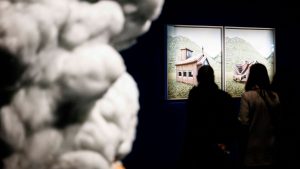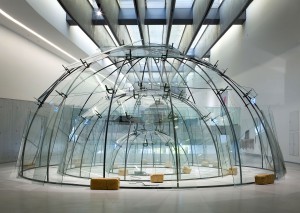opening hours
Monday closed
Tuesday to Sunday 11 am – 7 pm
Tuesday 24 December 11 am > 4 pm
Monday 25 December closed
Tuesday 31 December 11 am > 4 pm
Wednesday 1 January 11 am > 7 pm
Monday 6 January 11 am > 8 pm
- full price € 15 at the box office - € 14 online
- reduced price € 12 at the box office - € 11 online
for young people aged between 18 and 25 (not yet turned 25); for groups of 15 people or more; La Galleria Nazionale, Museo Ebraico di Roma ticket holders; upon presentation of ID card or badge: Accademia Costume & Moda, Accademia Fotografica, Biblioteche di Roma, Centro Sperimentale di Cinematografia, Enel (for badge holder and accompanying person), FAI – Fondo Ambiente Italiano, Feltrinelli, Gruppo FS, IN/ARCH – Istituto Nazionale di Architettura, Sapienza Università di Roma, LAZIOcrea, Palazzo delle Esposizioni, Amici di Palazzo Strozzi, Accademia Nazionale di Santa Cecilia, Scuola Internazionale di Comics, Teatro Olimpico, Teatro dell’Opera di Roma, Teatro di Roma, Università degli Studi di Roma Tor Vergata, Youthcard; upon presenting at the ticket office a Frecciarossa or a Frecciargento ticket to Rome purchased between 27 November 2024 and 20 April 2025
- open € 18
valid for one year from the date of purchase
- free
minors under 18 years of age; disabled people requiring companion; EU Disability Card holders and accompanying person; MiC employees; myMAXXI cardholders; registered journalists with a valid ID card; European Union tour guides and tour guides, licensed (ref. Circular n.20/2016 DG-Museums); 1 teacher for every 10 students; AMACI members; CIMAM – International Committee for Museums and Collections of Modern Art members; ICOM members; journalists (who can prove their business activity); European Union students and university researchers in art history and architecture, public fine arts academies (AFAM registered) students and Temple University Rome Campus students from Tuesday to Friday (excluding holidays); IED – Istituto Europeo di Design professors, NABA – Nuova Accademia di Belle Arti professors, RUFA – Rome University of Fine Arts professors; upon presentation of ID card or badge: Collezione Peggy Guggenheim a Venezia, Castello di Rivoli Museo d’Arte Contemporanea, Sotheby’s Preferred, MEP – Maison Européenne de la Photographie; on your birthday presenting an identity document
Collection
MAXXI’s Collection of Art and Architecture represents the founding element of the museum and defines its identity. Since October 2015, it has been on display with different arrangements of works.

other upcoming events
6 Jan 2025 12.00 pm
guided toursGuido GuidiCol tempo, 1956-2024
6 Jan 2025 04.30 pm
MAXXI for familiesOggetti incredibili e come progettarli
14 Jan 2025 06.00 pm
lectureMongolian Buddhist Art and Zanabazarby Geshe Lharampa Javzandorj Dulamragchaa
14 Jan 2025 06.30 pm
lectureIn movimento: danza, coreografia, architetturawith Susanne Franco
15 Jan 2025 06.00 pm
talkAnalisi, distruzione e rinnovamentowith Monia Ben Hamouda

































London, Bvlgari Hotel
The shortlist of the support and promotion of young artists’ award, promoted by MAXXI and BVLGARI, revealed in London.
The Award, which started in 2000 under the name of Premio per la Giovane Arte (Young Art Award), is the starting point and birth of the MAXXI art collection. Throughout the years it has been an important springboard for many artists.
Thanks to the extraordinary partnership with Bulgari, in 2018 the Award was renewed and expanded its horizons with the goal of promoting and enhancing not only Italian artists, but also foreign artists that in the last two years have produced a new project in Italy in public institutions and private realities.
2020 edition:
Selectors
Cecilia Alemani, Laura Barreca, Lorenzo Benedetti, Stefano Collicelli Cagol,Caterina Riva, Marianna Vecellio, CURA
Judges
Hou Hanru MAXXI Artistic Director, Bartolomeo Pietromarchi MAXXI Arte Director, Manuel Borja-Villel Museo Nacional Centro de Arte Reina Sofía Director, Emma Lavigne Palais de Tokyo President, Victoria Noorthoorn Museo de Arte Moderno in Buenos Aires Director.
MAXXI BVLGARI PRIZE 2020: THE FINALISTS
Giulia Cenci (Cortona IT, 1988, lives and works in Amsterdam and Tuscany) was chosen for “the aesthetic tension present in her work that restores sculpture to its central role within the visual arts debate, as well as for her reflection on society’s future scenarios.”
She was proposed by Marianna Vecellio, Curator at Castello di Rivoli, Turin, who writes: “The works of Cenci are hybrid forms, resulting from the coexistence between living beings and an environment that is violently attacked by human beings. Through the study of form, the works of Cenci address the idea of the living being in the light of contemporary philosophical theories, which refer to the current age as the Anthropocene, a geological era that is the product of an irreversible action by human beings on the environment. Her works are the result of a formal, political and ontological “composting” process, and encourage us to change the way we look at the world, matter and human beings.”
Tomaso De Luca (Verona, 1988, lives and works in Berlin) was chosen for “his ability to explore history’s different identities through the investigation of the role of objects in the contemporary social and political context”.
As Lorenzo Benedetti, Curator at Kunstmuseum in St. Gallen, who proposed him writes: “Through the use of drawings, sculptures, videos and installations steeped in literary, philosophical and general culture references, Tomaso De Luca experiments with formal solutions in which the collective imagination is placed in a dialogue with a broader cultural spectrum. De Luca questions the symptoms of our society. A character of obsolescence seems to be present in his works creating a form of resistance to the consumerist nature of our time.”
Renato Leotta (Turin, 1982, lives and works in Acireale, Sicily), was chosen for “the independent nature of his research within the Italian national art scene and for the narrative force of his works that echoes the existential condition of contemporary human beings.”
He was proposed by Marianna Vecellio, Curator at Castello di Rivoli, Turin, who writes: Like a true archaeologist of reality, he observes the landscape to study its constitutive elements and capture its transient phenomena. Using different media, such as sculpture, photography, video, drawing and primary materials such as earth, sand and salt, he captures fragments of experience and turns them into mental pictures. In his works, he presents the reconstruction of an imagery, and through it he also provides a reconstruction of the cultural identity of today’s humanity, Moreover, his practice creates a poetic combination of apparently distant elements, such as history and the Mediterranean, the memory of places and reality, the sea and the earth, the North and South of the world.”